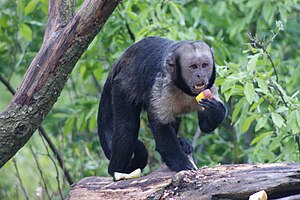Yellow-breasted Capuchin
| Yellow-breasted Capuchin | ||||||||||||
|---|---|---|---|---|---|---|---|---|---|---|---|---|

Yellow-breasted capuchin ( Sapajus xanthosternos ) |
||||||||||||
| Systematics | ||||||||||||
|
||||||||||||
| Scientific name | ||||||||||||
| Sapajus xanthosternos | ||||||||||||
| ( Wied , 1826) |
The yellow-breasted capuchin ( Sapajus xanthosternos , Syn . : Cebus xanthosternos ) is a primate species from the subfamily of the capuchin monkeys within the New World monkey .
features
Yellow-breasted capuchins are medium-sized primates with a head body length of 36 to 42 centimeters. The tail measures around 38 to 49 centimeters, it is graspable, but not a fully developed prehensile tail as in the spider-tailed monkey . At around 3.5 to 4 kilograms, males are significantly heavier than females who reach 2.5 to 3 kilograms. Their fur is predominantly reddish-brown, the upper arms, the chest and the belly are colored yellow in strong contrast. The face is pale brown, the hair on the cheeks and top of the head are black, as are the hands and feet.
distribution and habitat
Yellow-breasted Capuchins occur only in the coastal forests in eastern Brazil , their range includes parts of the south of the state of Bahia and possibly adjacent areas of Minas Gerais . In earlier times its distribution area probably extended north to the Rio São Francisco , today it has been greatly reduced and fragmented due to human influence. Their habitat is the coastal rainforests of the Mata Atlântica .
Way of life
Yellow-breasted capuchins, like all capuchin monkeys, are diurnal tree dwellers, where they tend to be in the middle and lower crown region. They live in groups of 10 to 30 animals, which are composed of several males and females and their offspring. Both genders establish a hierarchy.
They are omnivores that feed mainly on fruits and insects. They also eat other parts of the plant such as nuts, flowers and buds, but also bird eggs, spiders and other small animals.
Reproduction
The dominant male of the group enjoys priority in mating and sires most of the young. The female gives birth to a young animal after a gestation period of 150 to 170 days . The newborn weighs around 250 to 290 grams at birth. After a few months, they are weaned. Females become sexually mature at 4 to 5 years of age and males at 6 to 8 years of age.
Danger
Yellow-breasted capuchins are among the most endangered primate species. The main reason for this lies in the widespread destruction of their habitat, the Atlantic coastal forests have been largely cleared and only exist in the form of small remains. Hunting represents a further danger. The IUCN estimates that within the last three generations (48 years) the total population has declined by more than 80 percent. There are some groups in protected areas, but many of these occurrences are too small to sustain themselves in the long term. There are breeding projects in zoos that aim to ensure the continued existence of the species.
The species is listed in the IUCN Red List as " critically endangered ".
literature
- Thomas Geissmann : Comparative Primatology. Springer-Verlag, Berlin et al. 2003, ISBN 3-540-43645-6 .
- Don E. Wilson, DeeAnn M. Reeder (Eds.): Mammal Species of the World . A taxonomic and geographic Reference. Johns Hopkins University Press, Baltimore MD 2005, ISBN 0-8018-8221-4 .
Web links
- Sapajus xanthosternos (Wied-Neuwied, 1826) at ITIS
- Sapajus xanthosternos in the endangered Red List species the IUCN 2009 Posted by: M. C. M. Keirulff, S. L. Mendes, A. B. Rylands ,, 2008. Accessed on 5 November of 2009.
- Information and photos at arkive.org
- WAZA data sheet

